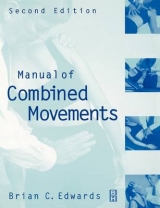
Manual of Combined Movements
Their Use in the Examination and Treatment of Mechanical Vertebral Column Disorders
Seiten
1992
Churchill Livingstone (Verlag)
978-0-443-04666-7 (ISBN)
Churchill Livingstone (Verlag)
978-0-443-04666-7 (ISBN)
- Titel erscheint in neuer Auflage
- Artikel merken
Zu diesem Artikel existiert eine Nachauflage
Aims to draw attention to the use of combined movements when examining and treating mechanical disorders of the vertebral column. It is intended that this manual is used in conjunction with the more complete texts of Maitland (1986) and Grieve (1988).
The purpose of this manual is simply to draw attention to the use of combined movements when examining and treating mechanical disorders of the vertebral column. It is intended that the manual be used in conjunction with the more complete texts of Maitland (1986) and Grieve (1988). The principles of technique selection in relation to movement pattern and category of patient i.e. acute, subacute and chronic have been suggested with the intention of providing a basis for the choice of initial direction. The rationale has then been expanded to incorporate a progression of treatment related to direction of movement and position of joint, rather than grade of movement; however, an understanding of the parinciples of the graded movement are essential to the total concept. Generally, it is hoped that the concept and use of combined movements will be seen to be a helpful and simple adjunct to the management of vertebral column disorders of mechanical origin.
The purpose of this manual is simply to draw attention to the use of combined movements when examining and treating mechanical disorders of the vertebral column. It is intended that the manual be used in conjunction with the more complete texts of Maitland (1986) and Grieve (1988). The principles of technique selection in relation to movement pattern and category of patient i.e. acute, subacute and chronic have been suggested with the intention of providing a basis for the choice of initial direction. The rationale has then been expanded to incorporate a progression of treatment related to direction of movement and position of joint, rather than grade of movement; however, an understanding of the parinciples of the graded movement are essential to the total concept. Generally, it is hoped that the concept and use of combined movements will be seen to be a helpful and simple adjunct to the management of vertebral column disorders of mechanical origin.
Subjective Examination of the Vertebral Column. Objective Examination of the Vertebral Column. Lumbar Spine. Upper Cervical Spine. Middle and Lower Cervical Spine and Thoracic Spine. Movement Patterns. Selection of Technique. Conclusion. Index
| Erscheint lt. Verlag | 9.3.1992 |
|---|---|
| Zusatzinfo | 100 ills. |
| Verlagsort | London |
| Sprache | englisch |
| Maße | 197 x 240 mm |
| Gewicht | 626 g |
| Themenwelt | Medizinische Fachgebiete ► Chirurgie ► Unfallchirurgie / Orthopädie |
| Medizin / Pharmazie ► Physiotherapie / Ergotherapie | |
| ISBN-10 | 0-443-04666-2 / 0443046662 |
| ISBN-13 | 978-0-443-04666-7 / 9780443046667 |
| Zustand | Neuware |
| Informationen gemäß Produktsicherheitsverordnung (GPSR) | |
| Haben Sie eine Frage zum Produkt? |
Mehr entdecken
aus dem Bereich
aus dem Bereich
Buch | Softcover (2023)
Urban & Fischer in Elsevier (Verlag)
CHF 85,40
für Studium und Praxis unter Berücksichtigung des …
Buch | Softcover (2022)
Medizinische Vlgs- u. Inform.-Dienste (Verlag)
CHF 39,20



